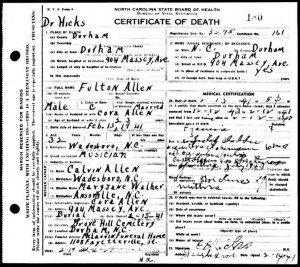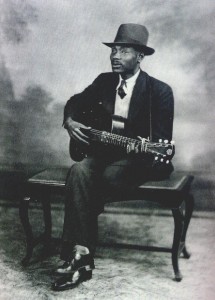“Let me play with your poodle”. Tampa Red has asked this in 1942, Sam Lightnin’ Hopkins reiterated the question some ten years later, and more recently in 1997 the Texan female blues singer Marcia Ball even dedicated a complete CD to this irksome plea. So both male and female liked to play with the other one’s poodle.
Hokum Blues was very popular in the twenties and the thirties, and its historical roots go back to the minstrelsy in the 18th century when, as part of a global comic act, “double entendre” or hidden references to either racial or sexual questions in humorous terms was performed much to the amusement of the audience in theaters or in the street. Hokum was a way of dealing in a euphemistic and humorist way with different forms of racial questions and/or sexual types of behavior.
After the economic depression had hit hard in 1929 leaving a desolate economic and social desert, one could have expected that blues would be a medium by which the hardships of life would find its expression. Nothing of the kind! Certainly, some blues artists sung about it, and the artist I’ll deal with below, used a lot of his songs to communicate about the hardships he suffered as a blind hobo in the thirties, but the general tone of blues in those days remained as it was before : it dealt with personal pain and joy, with the love for a woman, and the pain when she leaves or deceives. The undertone was very often sexual and the wording of the sexual connotation was sometimes soft, however sometimes also very overt, not very far away from plain pornographic insinuations.
Blind Boy Fuller, the man I want to elaborate a bit on now, had a repertoire of which hokum was a substantial part. Samual Chambers, in his ‘The Country Blues‘ standard book of 1959 brushes the scene of people gathered around a phonograph listening to Fuller’s music trying to guess as a kind of game what he really meant by his wordings. Sometimes however, it was not too hard to guess when he sung “I want some of your pie“, or “Sweet Honey Hole‘, or even “Get your Yas Yas out” (which inspired the Rolling Stones for their 1970-album : Get Yer Ya-Ya’ s out”).
Blind Boy Fuller was not his real name. He was born as Fulton Aller in a large family sometime between 1907 and 1910 (there is no definitive agreement on the precise date) in North Carolina, in the Appalachian region. The mountains of this impoverished region, stretching from the south to the north on the East Coast, formed a natural barrier for the migration flow of black families from the Mississippi to the North. The rough region contained a high degree of Afro-Americans and was an important breeding ground for the the blues. The folk music of the Appalachian is a unique mix of European (Scottish, Irish) and African influences which, by his geographical isolation, has developed its very own characteristics. The banjo music occupies an important place in it, and it is said that the roots of the Appalachian blues go further back in time to the African roots than the delta blues. The Piedmont finger-picking style of guitar playing is very typical of this East Coast blues.
Blind Boy Fuller has become one of the iconic figures of this Piedmont blues style. He summarized the style he heard from musicians around him as Gary Davis, Blind Blake and Blind Willie McTell, and also directly from field hollers, but transformed it to his very own, amazing guitar playing idiom, which made of him the last of the popular guitar blues artists before the World War II.
His life was very short, but he lived it intensely. Very little is known about his early youth. He learned himself how to play the guitar, and moved with his father when his mother died when he was young. He was not born blind but became totally blind in 1928; there is some discussion on whether this was the result of a disease or the outcome of a violent act.
Anyhow, he had to give up manual labor and went out on the street to play his guitar and started playing also at house parties. Two years before he got blind, he found himself a wife, though it was more in the form of a child since his spouse was only 14 when they got married. He found his poodle early in life.
The street life helped him to develop his craftsmanship further, and he also met a guy, later known by his artist name, Sonny Terry, an impressive harmonica player whose style fitted perfectly to Fuller’s way of guitar playing. It’s kind of ironic that the two met each other as Sonny Terry himself was nearly blind when they joined together, and eventually started living in the same house as friends.
Blind Boy Fuller’s playing was very suited to play as accompaniment to others. One of those co-players that followed him was Floyd Council. Syd Barret inspired him to name his pop group ‘Pink Floyd’ by the names of Floyd Council and Pink Anderson he spotted on Fuller’s LP “Country Blues”.
Later on, he would also join team with Brownie McGhee, another great guitarist who would become in the decades ahead a steady duo with Sonny Terry.
In 1935 he was noticed by a white talent scout (not really interested in blues, only in the money that he could make out of it) who brought him and his friends to record in New York. Fulton Allen not being a name that would sell, his visual handicap was cleverly used as a marketing tool : he sung for the first time as ‘Blind Boy’ Fuller. And, he got successful: in his short recording career of only 6 years his music was registered on more than 135 sides !
His combination of styles and masterful guitar finger-picking work contributed largely to the broad audience he acquired. It was the time of the party blues.
As I stated elsewhere: blues dies young. The intense life he lived, abundantly oiled by hard liquor, presented its bill already in the first year of WW II, when a kidney failure and bladder problems stopped the sound of his guitar and voice. His death certificate n° 180 mentions the date of February 13th 1941 and quotes him as ‘musician’.




Do you write all these yourself? They are excellent; presentation as well as content.